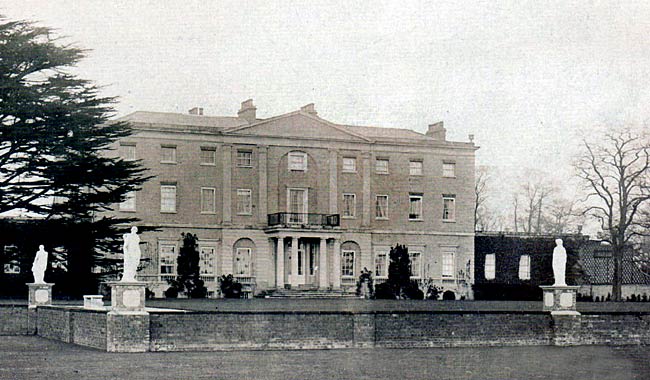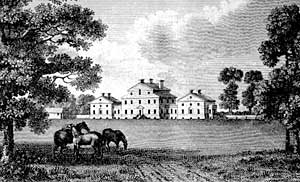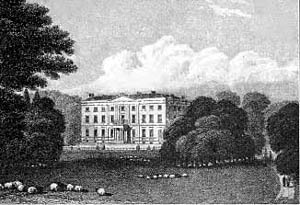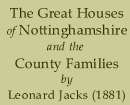< Rufford | Contents | Sherwood Lodge >
Serlby

The north front of Serlby Hall, c.1905.
HERE is already the faintest suspicion of autumnal colour in the beechen avenues of Serlby, in the very north of the county. It is a famous place for beeches, almost as large and as towering as those which fringe a celebrated Thames district. To reach the hall you have to pass through a fine beech avenue. The trees are tall, stately, and of uniform height. They are in full leaf on this August day, and in the transient periods of sunshine the road bestrewn with the green-looking little husks, which contain the tiny fruit of these giant trees; is flecked with restless patches of light. These trees are in the park, and they follow the curve of the road, which dips into the hamlet of Serlby, whose few houses are occupied by Lord Galway’s people, and belong to the estate. From the Bawtry side you get no distant view of Serlby. Its white walls come upon you suddenly—you pass through a slender iron gate, large enough to admit a carriage, flanked by a dark growth of shrubbery, and the few yards of crisp gravel walk lead to the south front of the family residence of the Moncktons. The owner of Serlby may well be proud of his ancestral beech trees. Here these tall giants of vegetation, standing in almost military exactitude, have drawn their forces nearly up to the house, as though they had a desire to become domesticated, but dare not make further advances in that direction. The broad gravel walk that runs parallel with the mansion, terminates with an avenue of beeches, which provides a delightful vista. One half of the avenue is carpeted with a soft green moss, whose growth has been encouraged. At the extremity there are a couple of statues, and there, is a lovely stretch of open country, grassy and well wooded. The moss carpet, which is velvety and soft, has been torn in places by birds in search of insects. The woods are intersected by beech avenues, some of which are narrow and fairy-looking. They are all of them quiet and unfrequented. Rabbits, silver grey and brown, abound in the woods, and with a confidence in human tolerance, which their kind do not usually display, venture onto the lawn in front of the house.

Serlby Hall in the late 18th century.
In 1727 John Monckton was created a peer of Ireland— Viscount Galway and Baron Killard—and in that year he purchased the Serlby estate, soon after his marriage with a daughter of the Duke of Rutland. The Moncktons can claim long descent, and it cannot justly be said that their lives have been useless, idle, or undistinguished. As early as 1545, William Monckton, of Cavil, in Yorkshire, in obedience to the command of his Sovereign, repaired with his tenants and retainers to Newcastle, there to oppose the threatened invasion of the Scots and the French. The title has extended into a seventh generation, and the heads of the house have generally been legislators. The first Viscount represented Clithero, in Lancashire, and Pontefract, in successive Parliaments, was appointed a Commissioner of his Majesty’s Revenue in Ireland, and afterwards Surveyor-General of the King’s " Honours, Woods, Forests, &c., in England and Wales." In 1741 his lordship received the degree of LL.D. on the installation of the Duke of Newcastle as Chancellor of the University of Cambridge. The second Viscount was appointed receiver of his Majesty’s crown and farm rents in several counties, and he was returned Member of Parliament for Pontefract and Thirsk. The first Viscount was Member for York and Pontefract, and a Privy Councillor. The sixth and late Viscount, who died in 1876, represented the Hundred of Bassetlaw for many years, and was at one time a Lord-in-Waiting to the Queen. The present Lord Galway was first returned to Parliament for North Nottinghamshire, in 1872, when Mr. Speaker Denison was raised to the peerage. He has retained the seat since, and in the fourth session of Lord Beaconsfield’s last Government he was selected to move the Address to the Throne in the Commons. Stored away at Serlby there is an old and rusty helmet, in which decay has eaten great holes. A stream of rusty particles escape from it as Lord Galway takes it from a cupboard for my inspection. This now delapidated head gear once gleamed in the battle field. It was worn by Sir Philip Monckton, whose portrait, by Lely, hangs in the dining room at Serlby. Sir Philip was a brave man, and a distinguished soldier, and his loyalty to the First Charles frequently brought him into difficulties. He fought at Marston Moor, and in half-a-dozen other engagements. His property was twice confiscated, twice his horses were shot from under him, and on one occasion being wounded, he continued fighting with his bridle between his teeth until he was again severely wounded, and made prisoner.

Serlby Hall in 1830. The 18th century house was remodelled by Lindley & Woodhead of Doncaster in 1812.
Serlby is a comparatively modern mansion, with an extensive south front, the plainness of which is agreeably broken by a collonaded portico, forming the principal entrance to the house. It enjoys a superb situation. Facing it, stretches a fine expanse of park land, planted with abundant trees—beech and oak—and distributed in that wilful manner, which secures picturesqueness, where methodical arrangement, or observance of any definite rule of order, would fail. The scene is brightened in one direction by the appearance of a lake, whose surface gleams through the openings in the trees, as also does that of a small wandering stream, which holds trout, I should think, and takes its course to the lake. The end window of the south front, that nearest the quiet beech avenues, and the two handsome cedar trees, which spread their sombre layers far and wide, belongs to the library. In the room is a fairly comprehensive collection of books, and some fine old pictures, chiefly portraits of celebrities by distinguished artists. Amongst them is a Canaletti, which has attracted much attention whilst it has hung there. A few of the best of the Serlby pictures have been exhibited at various times in some of the public galleries of art—notably that at Nottingham Castle. The walls at Serlby are innocent of modern pictures ; the collection is one of old masters. There are portraits by Vandyck, distinguishable by the inexpressible grace of the head, and the delicate beauty of the hands, the flesh transparent enough to show the deep blue of the veins through which the life-current flows ; there are masterpieces of colour displayed in portrait painting, by Sir Peter Lely there are specimens of Holbein’s work, and Hogarth is not misrepresented. There is a gigantic picture, bearing the sign manual of the pleasure-loving and extravagant Daniel Mytens, covering the end of one of the rooms; there are several Canaletti’s, and the charm of Paulo Panini, whose paintings, chiefly of the ornaments of modern Borne, were esteemed no less for grandeur of architecture, and for truth of perspective, than for their limpid clearness of colour is not wanting. These pictures have been in the family for generations, and when, by the kindness of Lord Galway, they are away on exhibition, they leave an almost painful blank upon the walls, and create an appreciable void in the house. There are a few large pictures in the entrance hall. Some foxes, which have occupied the brush of Renique, are enjoying themselves with a reckless demeanour, which suggests complete forgetfulness of the fangs of the Grove hounds, and a very fine collection of stag heads, which is arranged about the staircase and passages, gives additional evidence that the lord of Serlby is a follower of sport. These are the heads of animals shot in Scotland by the sixth Lord Galway and his son. The most striking pictures in the hall are a fine portrait of Charles the First, by Vandyck, and a large and well-preserved painting representing William the Third entering London, amid all the splendors of a Royal ceremonial. In half-a-dozen frames arranged in the drawing room, from whose windows there is a delightful view, there are portraits by Vandyck. There is his Royal patron, at whose hands the painter received the Monarch’s own portrait set in diamonds, and Henrietta, his Queen. There is the Duchess of Buckingham and her family, the Earl of Bedford, and Lord Pembroke. The fine painting on wood of Henry VIII. is by Holbein; hanging in a line with it are the features of Nicholas Cratzer, Royal astronomer. These pictures have been exhibited at South Kensington, and other places, and possibly may be away at the present time. Panini’s picture here is the interior of St. Peter’s. There are some views of Venice, by Canaletti, and the original sketch of the " Descent from the Cross." The picture of Mytens, already alluded to, is remarkable, both for size and quality, if such an association of words may be employed to describe a great work of art. It is 12 feet 2 inches in height, and 15 feet 4 inches in breadth. The principal figures are those of Charles the First and his Queen, with two horses, one of them carrying the curious side saddle of the period, and dogs, observable amongst which latter is the monster King Charles’ spaniel. In the foreground, Geoffrey Hudson, the dwarf, is exerting all his strength to keep in check a couple of dogs, which are exhibiting a desire to be demonstrative. All the figures are life size, and the picture is so large that some time back, when it was lent to an exhibition at Manchester, it had to be conveyed by road. In the company of Kings and Queens, and of his less warlike descendants, appears Sir Philip Monckton, of the rusted helmet, I had seen previously. Sir Philip’s son occupies a place at his warrior father’s right; and they are surrounded by an array of ancestors and descendants, including the first, second,.third, and sixth Viscounts, the last a striking portrait by Sir Francis Grant. There are also in this distinguished company, General Monckton, who took command at Quebec on the occasion of General Wolfe’s death—a fine picture by Weste; the Marquis of Granby, whose memory has been perpetuated by countless sign painters, with more or less consistency, and the famous Lady Cork.
Each Sunday, Divine service is held in a little chapel attached to the hall, and containing Vandyck’s representation of "The Crucifixion." Within the pleasure grounds there is a large mound, thickly covered with leafy shrubs and tangled undergrowth. This was once the site of a church, all traces of which have long since disappeared, just as the village of Farworth, the smoke of whose quiet cottages, curled among the trees near Serlby Hall, has disappeared. Not a vestige of the village remains, but the plough occasionally unearths some remnant of brick or stone which once belonged to the foundations. Many years ago, Serlby had a rare collection of statuary, but the graven images, which once adorned its halls, have departed. One or two specimens are still preserved in the grounds. They are lichen grown, discoloured by climatic influences, and smoke. Formerly a portion of what now is the lawn in front of the house was used as a bowling green, a use to which it has been a stranger these many years. The gardens are laid out in Dutch fashion, and they contain some fine shrubs, including two small fir trees, brought from Nova Scotia, which seem to thrive in North Nottinghamshire soil. In one of the divisions of the kitchen garden there is a venerable mulberry tree, a very fine specimen, which may at one time have attracted the attention of Cardinal Wolsey, for it is supposed that it once adorned the episcopal palace at Scrooby, which was the occasional residence of this celebrated dignitary. In these gardens the edelweiss, a plant whose flowers Mark Twain contemptuously likens to cigar ashes, grows in small quantities. It is said to preserve the person who wears it from ill, but, as it prefers the ice-bound soil of Alpine regions to the more kindly nutriment of this country, it does not often appear in English button-holes.
< Rufford | Contents | Sherwood Lodge >
